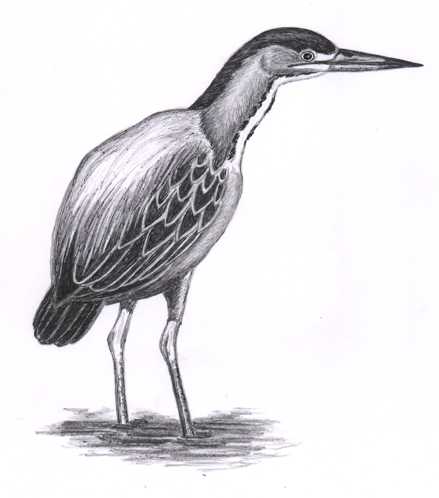
Dear Bird Folks:
Last week, while I was on Cape Cod, I saw a heron attacking, what I thought were baby crows in their nest. I’ve always thought that herons only ate fish. Why would they be going after those poor little baby crows? Is there a shortage of fish?
-Dawn, Souderton, PA
Yeah Dawn,
There is a shortage of fish. Haven’t you been reading the papers or seen the price of fish in the fish market? Actually, there may be more crows around than fish, considering the number of complaints that I get about crows waking people up at 5:00 AM. But fish population aside, I don’t think the heron that you saw was attacking baby crows. In fact, I don’t think what you saw was even a crow’s nest. Like you said, herons eat mostly fish and not birds. And crows are such protective parents, that if a crow’s nest is attacked, every crow east of Wyoming will come screaming to defend it. Therefore, I think what you saw was a parent Green Heron attending its own babies in its own nest. Really.
Green Herons, unlike most herons, usually don’t nest in colonies. Around here they often nest alone in Pitch Pines. Although a heron’s stick platform nest doesn’t look much like a crow’s bulky nest, I can see how it you would be fooled. Most folks would expect to find a heron’s nest in a marsh or wetlands, but Green Herons will build their nests just about anywhere, including in the woods, as long as there is water nearby.
It is this nesting flexibility that makes the Green Heron one of the most widespread and abundant of all our herons. Other herons nest in colonies. While nesting in a group has some advantages, they also can be easily devastated by toxic spills, human interference or storms.
The Green Heron is the smallest heron that we regularly see here on Cape Cod. It can be seen just about anywhere there is water. To a Green Heron any kind of water will do, whether it be an inland fresh water stream, a coastal saltwater marsh or an Evian filled goldfish pond in the middle of Osterville.
Although Green Herons do have tinges of green on them, they would hardly be confused with one of the Celtics. Better field marks to look for are their smaller size, a slight head crest and legs that are so brightly colored orange it seems as if they’ve just finished a meal of Cheese Doodles.
Green Herons are most often seen at the waters edge patiently stalking fish. They seem to stand still for hours waiting for fish to come within range of their lightning quick beak. They also are one of the few creatures to have been observed using tools. Green Herons will sometimes take a twig, seed or insect and drop it on to the water’s surface. When a fish comes along to investigate the floating object it instantly becomes sushi to go.
Like all herons, the green heron’s most important hunting tool is its long neck. The recoiling neck provides the speed for snapping up fish. To protect the important parts of its throat from damage during strikes, the esophagus and trachea of a heron actually wind behind the bird’s neck bones. Thus protecting the bird from losing its beautiful singing voice if its neck smashes into a log or stone while lunging at fish.
You would think that a bird with such a long flexible neck would be able to produce pleasant sounds (I was kidding about the beautiful singing voice earlier), but Green Herons can only produce clucks and a weird one note “skew” call. Although these calls aren’t great to listen to, it is good to learn them, as they help with identification. And when you think about it, what kind of song could you expect from a bird whose throat is on backwards?